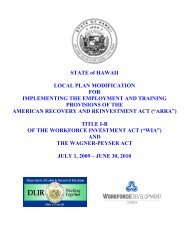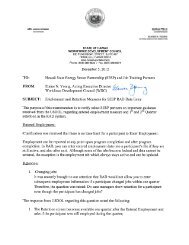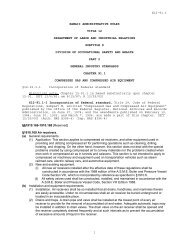Hawai i's Green Workforce A Baseline Assessment December 2010
Hawai i's Green Workforce A Baseline Assessment December 2010
Hawai i's Green Workforce A Baseline Assessment December 2010
Create successful ePaper yourself
Turn your PDF publications into a flip-book with our unique Google optimized e-Paper software.
In contrast, industries that contribute the least<br />
vacancies in the green labor market are Mining,<br />
Transportation and Warehousing, Information,<br />
Finance and Insurance, Real Estate and Rental and<br />
Leasing, Management of Companies & Enterprises,<br />
and Accommodation and Food Services (Table<br />
11). This might suggest that the greening of these<br />
industries is mature or has not yet fully begun. In<br />
particular, given the limited opportunities for the<br />
excavation of minerals and metals in <strong>Hawai</strong>’i, we<br />
would not expect to see a large number of green job<br />
vacancies in the Mining sector. From an operational<br />
perspective, low vacancy levels in functional areas<br />
such as leadership (Management), capital (Finance)<br />
and risk mitigation (Insurance) are likely because: (1)<br />
these industries account for fewer jobs relative to the<br />
overall economy; (2) these jobs are less likely to be<br />
recognized as “green” given that they cover a wider<br />
spectrum of administrative and generalist activities;<br />
and (3) some of the positions may be of a broader<br />
nature (e.g., chief operating officer or chairman of the<br />
board).<br />
Vacancies by Core <strong>Green</strong> Areas<br />
When the data are assessed by core green areas,<br />
most of the job vacancies appear within Generating<br />
Clean, Renewable, Sustainable Energy and Natural<br />
Environmentally Friendly Production. This is<br />
particularly the case in O‘ahu, with 219 vacancies in<br />
the category. Ninety-five of the County of <strong>Hawai</strong>‘i’s<br />
199 green vacancies are in the Natural Production<br />
category (Figure 9).<br />
Reviewing job vacancies across firm size, mediumsize<br />
worksites account for substantially more green<br />
vacancies than small and large worksites. In the<br />
Generating Clean, Renewable, Sustainable Energy<br />
category, for example, data show that medium-size<br />
firms hold 163 green vacancies. Medium-size firms<br />
also account for the majority (98) of vacancies within<br />
the Natural Environmentally Friendly Production<br />
category, representing 87 percent of the vacancies in<br />
this category (Figure 10). Interestingly, almost all of<br />
these vacancies also originated within the Agriculture,<br />
Forestry, Fishing, and Hunting category.<br />
Figure 10. <strong>Green</strong> Job Vacancies by Core Areas & Worksite<br />
Size<br />
Vacancies by Occupation<br />
Table 12 depicts present estimated green job vacancies<br />
by occupational title relative to the total estimated<br />
green jobs in <strong>2010</strong> and those projected in 2012. The<br />
top-seven occupations -- Sales Engineers, Solar<br />
Photovoltaic Installers, Graders and Sorters of<br />
Agricultural Products, First-Line Supervisors and<br />
Managers of Production and Operating Workers,<br />
Electricians, Retail Salespersons, and Janitors and<br />
Cleaners -- include 50 percent of the total green job<br />
vacancies.<br />
The three occupations of Sales Engineers, Solar<br />
Energy System Engineers, and First-Line Supervisors<br />
each have large numbers of vacancies, including<br />
relative to total current jobs. Their vacancies are<br />
between one to two times their total current green<br />
jobs. These figures may be a result of both an<br />
anticipated expansion of these occupations and the<br />
lack of a skilled and qualified labor pool from which<br />
to fill the positions.<br />
Examination of the 2012 projected green jobs figures<br />
is instructional in showing change for each of the<br />
three occupational categories. The data shows that in<br />
all three occupations, projected job increases ranged<br />
from 196 percent to over 485 percent. These findings<br />
suggest that the present high vacancy rates in these<br />
jobs may not only be a function of lack of qualified<br />
potential employees, but also of expected expansion of<br />
green jobs in the near future.<br />
<strong>Hawai</strong>ÿi’s <strong>Green</strong> <strong>Workforce</strong>: A <strong>Baseline</strong> <strong>Assessment</strong> 25
















